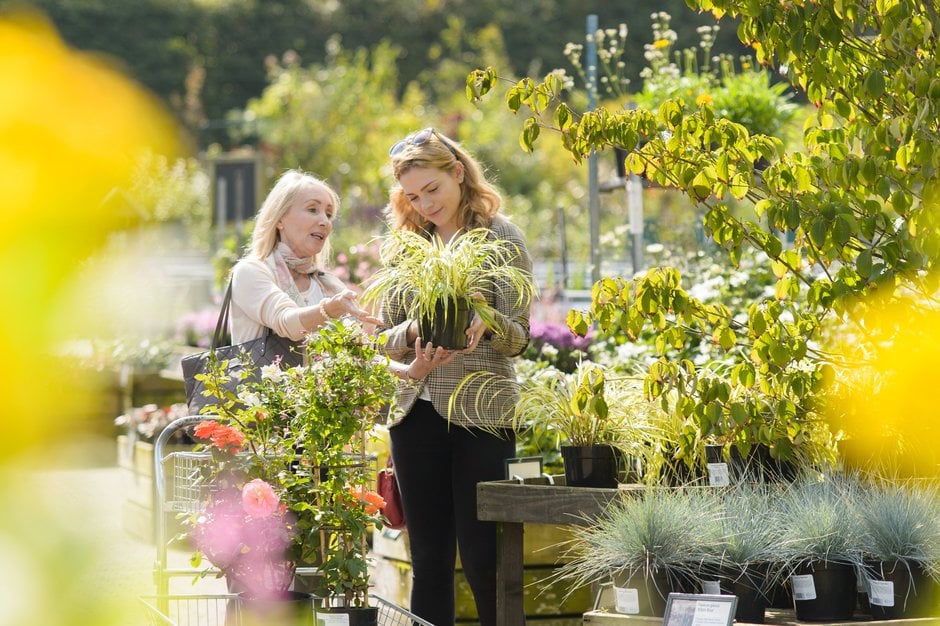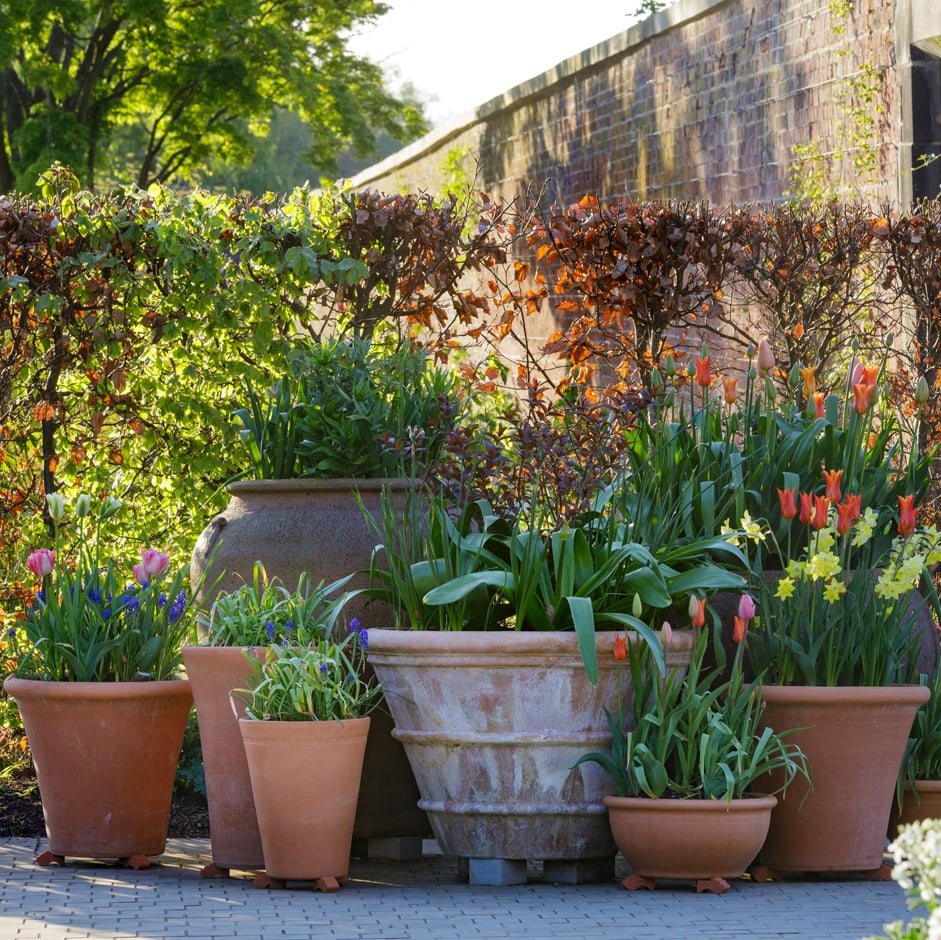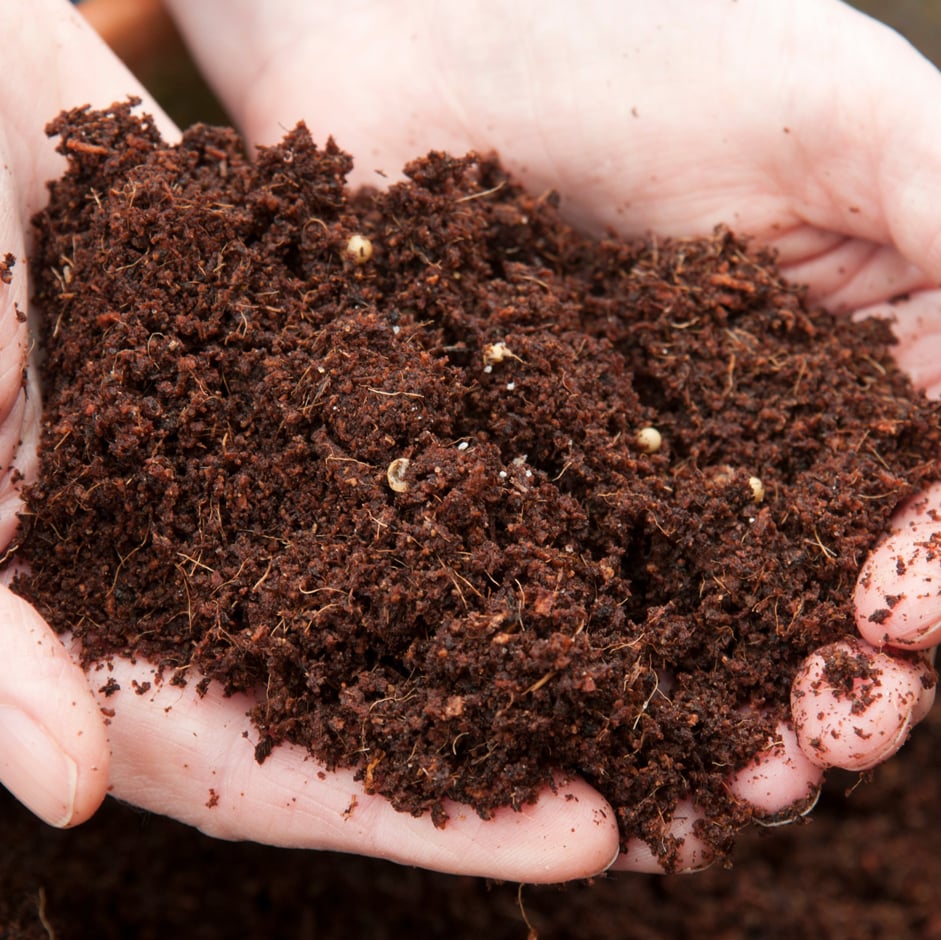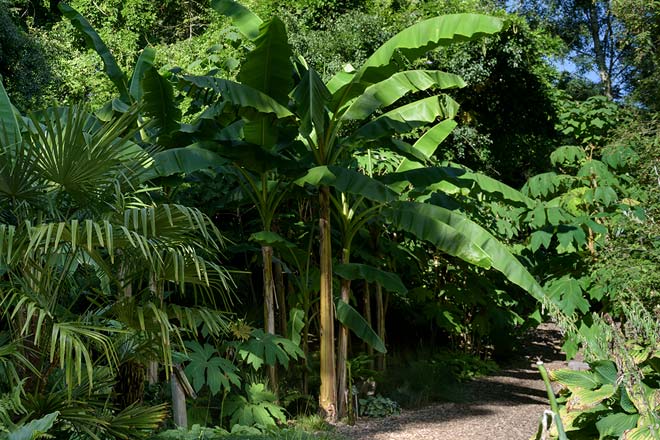Growing guide
How to grow banana plants
Banana plants, with their huge paddle-shaped leaves, add tropical drama to warm, sheltered gardens in summer. Although most are tender and must be brought indoors over winter, some hardier types may survive outdoors in milder parts of the UK if well protected.
Quick facts
- Large, exotic-looking leaves in summer
- Grow in a warm, sheltered, sunny spot
- For containers and borders
- Large, vigorous plants, up to 3m (10ft) or more
- Most are tender, so keep indoors in winter
- Rarely flower or fruit outdoors in the UK
All you need to know
What are banana plants?
Banana plants bring tropical spectacle to gardens over the summer months. And while they rarely flower or fruit in the UK, they are still real show-stoppers, with exotic arching leaves up to 2m (6⅔ft) long. Mature plants can grow to 3m (10ft) tall or more.
Although they often resemble trees, bananas don’t form a woody trunk and botanically are classed as herbaceous perennials. They can live for many years, as long as they're well protected from cold every winter.
Musa and Ensete are the two main types of banana grown in the UK. You may find several species and cultivars of these on sale, which may differ in size or leaf colour.
Most banana plants are tender, so they must be protected from frost.
How and what to buy
Bananas are usually sold as potted plants, at various sizes, from about 30cm (1ft) tall to 1m (3ft) or more. They are available in many garden centres, mainly in spring and summer, but usually only the most popular types. For tips on choosing good quality plants, see our guide to buying from garden centres.
For a wider choice of cultivars, go to tropical nurseries and online plant suppliers. See our guide to buying plants by mail order.
The two most widely available bananas are:
-
Japanese banana (Musa basjoo) – the hardiest banana, it can survive winter outdoors in mild parts of the UK and in warm cities, and possibly elsewhere if well wrapped
-
Red Abyssinian banana (Ensete ventricosum ‘Maurelii’) – a tender
cultivar with large red-tinted leaves, with red mid-ribs beneath, and dark red stalkGardeners often use the word variety when referring to a specific plant, but the correct botanical term is 'cultivar'. Whichever word you use, it means a distinctive plant or plants, given a specific cultivar name and usually bred to enhance certain characteristics, such as flower or fruit size, colour, flavour or fragrance, plant size, hardiness, disease resistance, etc. Additionally, it is worth knowing that, botanically, variety has another meaning - it refers to a naturally-occurring distinct plant that only has slight differences in its looks. For example, Malva alcea var. fastigiata differs from typical plants by having an upright habit.
Both of these have an RHS Award of Garden Merit, which shows they performed well in RHS trials, so are reliable choices.
For more on the various banana species and cultivars, go to RHS Find a Plant. Search for ‘Musa’ to browse photographs and plant descriptions, and find out where to buy them.
Bananas suit a wide range of garden styles. They make striking additions to tropical-style borders and contemporary urban courtyards, and act as dramatic focal points. Their lush, bold leaves work well in a vibrant border display and add an exotic holiday vibe to a sunny patio.
Most bananas won't flower or fruit outdoors in the UK, although some may do so in a heated greenhouse or conservatory. However, in very mild parts of the UK and particularly long, hot summers, you could possibly get flowers outdoors on Musa acuminata ‘Dwarf Cavendish’, M. ornata, M. veluntina and M. lasiocarpa.
Over winter, most bananas must be brought indoors or into a heated greenhouse. The Japanese banana (Musa basjoo) is the hardiest species and may survive outdoors in a warm, sheltered spot, if wrapped in insulating material. So make sure you have the time and space to do this.

Tips on choosing healthy plants
Where to plant
Bananas can be grown outdoors in summer in borders and large containers. Smaller plants can also be grown as houseplants, in a conservatory or heated greenhouse, either all year round or just over winter.

Choosing the best houseplants

Tips on choosing healthy plants
When positioning the container or planting in a border, choose a location that provides:
-
Warmth and sun for all or most of the day
-
Fertile soil or compost that doesn’t become waterlogged or extremely dry
-
Plenty of space, so the plant can be displayed to best advantage. Depending on how large your plant is, its leaves can extend for several metres, so avoid squashing it into a cramped spot
-
Shelter from wind, to stop the leaves getting too shredded
When to plant
Plant outdoors from late spring to early summer, after all risk of frost has passed in your area.
Before moving a plant outside in spring, or planting a new specimen outdoors, acclimatise it gradually first – see our guide to hardening off.
How to plant
Bananas are easy to plant and should settle in quickly and grow away rapidly.
Planting in borders
These vigorous plants need rich soil, so before planting dig in plenty of well-rotted mature or garden compost.
Perennials: planting

Tips on choosing healthy plants
Planting in a container
-
Plant into a large container that can easily accommodate the rootball and also provide room for growth
-
Use loam-based compost, such as John Innes No 3. Mix in plenty of grit (30 per cent by volume) to improve drainage

Growing plants in containers

Peat-free compost choices
From late spring to late summer, banana plants grow rapidly, so need regular watering and feeding. In winter they must be protected from frost.
Watering
Bananas need regular and generous watering through spring and summer, especially in warm weather.
This applies particularly to plants growing in:
-
containers, as less rainfall reaches the compost
-
fast-draining soil, such as sandy soil
-
areas of low rainfall
See our guide to watering.
Watering in winter
When plants in containers are brought indoors over winter, reduce watering. Let the compost dry out before the next watering.
If you have a very mild, sheltered garden and wish to keep a containerised plant outdoors over winter, make sure it's protected from excess winter rainfall, as soggy, cold compost can kill the roots. If possible, move it into the lee of a wall or under the eaves. Also, raise the container up on bricks, to keep the drainage holes clear.
Water: collecting, storing and re-using
Feeding
Bananas can put on a lot of rapid growth in spring and summer. Plants in a container or in poor soil, in particular, will benefit from additional feeding.
A spring feed will help to get bananas off to a good start:
-
in borders, scatter a general-purpose feed over the soil surface, then cover with mulch
-
in containers, mix a slow-release feed into the compost at planting time or when re-potting into a larger container
You can also apply a general-purpose liquid feed weekly through spring and summer. This is particularly beneficial to plants in containers, as they have less access to nutrients than those in the ground.
Container maintenance
Plant nutrition: feeding plants
Re-potting
Bananas are vigorous plants and should be moved into a larger container either every spring or every other spring. This will help them to keep growing strongly.
-
With younger plants, increase the container size (diameter) by 5–7.5cm (2–3in)
-
As the container size increases, so will the size and vigour of the plant
-
Once the container size is 30cm (1ft), increase by 10–15cm (4–6 inches) every two to three years
Flowering and fruiting
Most bananas won’t flower or fruit outdoors in the UK, as temperatures are too low. Still, in very mild locations, such as Cornwall, established plants have been known to flower during long hot summers.
When grown in a sunny conservatory or heated greenhouse all year round, bananas may flower and even produce (usually inedible) fruits. The most likely to flower are Musa acuminata ‘Dwarf Cavendish’, M. ornata, M. veluntina and M. lasiocarpa.
To produce fruit, established bananas need a long, sunny growing season of nine to 15 months, with temperatures above 15°C (60°F) and ideally 27°C (81°F). Fruits then need a further two to four months to ripen.
Feeding with a high-potassium fertiliser may boost flowering and fruiting.
Mulching
After planting in the ground, apply a generous mulch of garden compost around the base of the plant. This will help to hold moisture in the soil and deter weed germination.
Apply to damp soil, and leave a gap of 7.5cm (3in) around the base of the stem, to prevent rotting.
If leaving plants in the ground over winter, apply a thick layer of mulch over the root zone as insulation – see our guide to protecting plants with mulch.
Overwintering
Indoors
Most banana plants are tender and won’t survive frost, so it is safest to bring them indoors over winter.
Younger plants are generally more vulnerable to cold, along with those in containers, as the roots are exposed to lower temperatures. Some very tender cultivars may need to be brought indoors as early as October, depending on your local climate.
If possible, keep plants in a warm sunny room, conservatory or heated greenhouse over winter. Water occasionally.
However, bananas can grow quite large, so bringing a whole plant indoors may be difficult. So another option is to reduce the plant's size and store it in a dormant state over winter:
-
Cut off the foliage, leaving the stem intact, then dig up the plant or take it out of its container
-
Remove surplus soil from the rootball, dry it out for a few days, then place in a container of barely damp sand or compost
-
Store this in a dark, cool but frost-free place, such as a garage
Outdoors
Musa basjoo is the hardiest species and may survive outside over winter in milder parts of the UK or in very sheltered sites and warm city gardens. Still, it is a risk, and to be on the safe side:
-
In autumn, cut off all the foliage, leaving just the main stem. Then wrap the stem in fleece or hessian and straw, to protect it from harsh weather – see our guide to overwintering tender plants and our guide to wrapping bananas
-
Spread a thick layer of mulch over the root zone – see our guide to protecting plants with mulch
-
With plants in containers, protect their vulnerable roots by wrapping insulating layers of bubblewrap, fleece or hessian around the container
-
Even if the top growth is severely damaged, bananas may re-sprout from the base in spring, especially well-established specimens

Preventing winter damage
Caring for older plants
Banana plants can live for many years. In mild, sheltered locations in the UK, Musa species, including hardy Musa basjoo, may send up new stems (suckers or offsets) from their underground rhizome. In this way they can eventually form an impressive multi-stemmed clump, reaching 3m (10ft) tall or more.
If a clump gets too dense or outgrows its space, you can detach the younger stems or offsets that form around the base. Dig down and sever them from the mother plant, ensuring each has plenty of roots.
If a mature plant gets too tall, you can cut back the top growth with a pruning saw, to a point anywhere on the stem, leaving at least 60cm (2ft) at the base. If done during the growing season, new leaves will soon sprout from the top of the cut stem.
Plants in containers should be re-potted in spring to encourage growth. Large, vigorous plants should be re-potted every two to three years, into containers that are 10–15cm (4–6in) wider. If a plant gets too large to re-pot easily, you can reduce the height of the stem, but ideally leave at least 60cm (2ft).
Bananas don’t generally need pruning. But to keep them looking their best, you can cut away old leaves when they start to die or look tatty. Use a sharp knife or secateurs, and cut at the base of the leaf stalk.
If your plant grows too tall, you can prune to reduce its size at any time during the growing season. The easiest way is to simply remove some of the tallest leaves. For a more drastic reduction, you can saw through the stem at any point above 60cm (2ft) from the base. New leaves should sprout from the top of the shortened stem.
When wrapping up plants outdoors for winter, cut off the leaves so you are just left with the main stalk.
When bringing plants indoors for winter, you can cut off all the leaves if space is tight.
You can grow new banana plants from bought seeds or by separating off new plants that may sprout around the base.
By seeds
Seeds of several species and cultivars can be bought from online seed suppliers and some garden centres. Seeds may offer an opportunity to grow unusual species that may not be widely available as plants.
They are easy to grow in warm conditions:
-
Lightly file one side of each seed, then soak in warm water for 24 hours
-
Sow individually, 1cm (½in) deep, in pots of seed compost
-
Place in a warm location, ideally in a heated propagator, at 21–24˚C (70–75˚F). Keep the compost slightly damp but not soggy, otherwise the seeds may rot
-
Fresh seeds should germinate quickly, while older seeds may take up to six months
-
Gradually move seedlings into more light and increase watering and feeding to encourage growth
By offsets
Established plants of most Musa species produce new plants, known as offsets or suckers, around the base. These grow up from the underground rhizome, and can be detached to form new plants:
-
In spring, dig down to the rhizome and detach the offset shoot carefully, with as many roots as possible
-
Remove some of the lower leaves and pot up into a container that is just large enough to accommodate the roots
Ensete bananas don’t produce suckers, so must be grown from seed.
Propagation techniques
Bananas are tropical plants and don’t always cope well with British weather, especially cold, wet winters, gales and dry summers. Look out for:
-
Damaged leaves – may be caused by cold, sun scorch or hail. Always take care to harden plants off before planting out in spring, after the last frost
-
Die-back of the crown – usually due to cold damage, but may also be caused by rot, encouraged by excessive moisture, especially over winter
-
Limp leaves – usually a sign of under- or over-watering. Check the compost and increase or decrease watering as necessary
-
Brown edges to leaves – probably insufficient water or low humidity
-
Shredded leaves – common in windy, exposed sites. This is a natural adaptation to tropical storms and does no harm to the plant. To keep the leaves intact, grow in a sheltered position
Pests
Bananas are rarely troubled by pests. However, when growing indoors, they are susceptible to several glasshouse pests including:
Controlling pests and diseases without chemicals
Preventing pest and disease problems

Discover bananas
Everything you need to know about choosing the right bananas for you
Get involved
The Royal Horticultural Society is the UK’s leading gardening charity. We aim to enrich everyone’s life through plants, and make the UK a greener and more beautiful place.